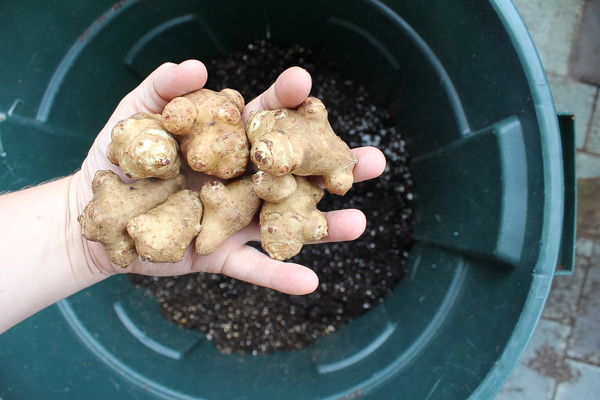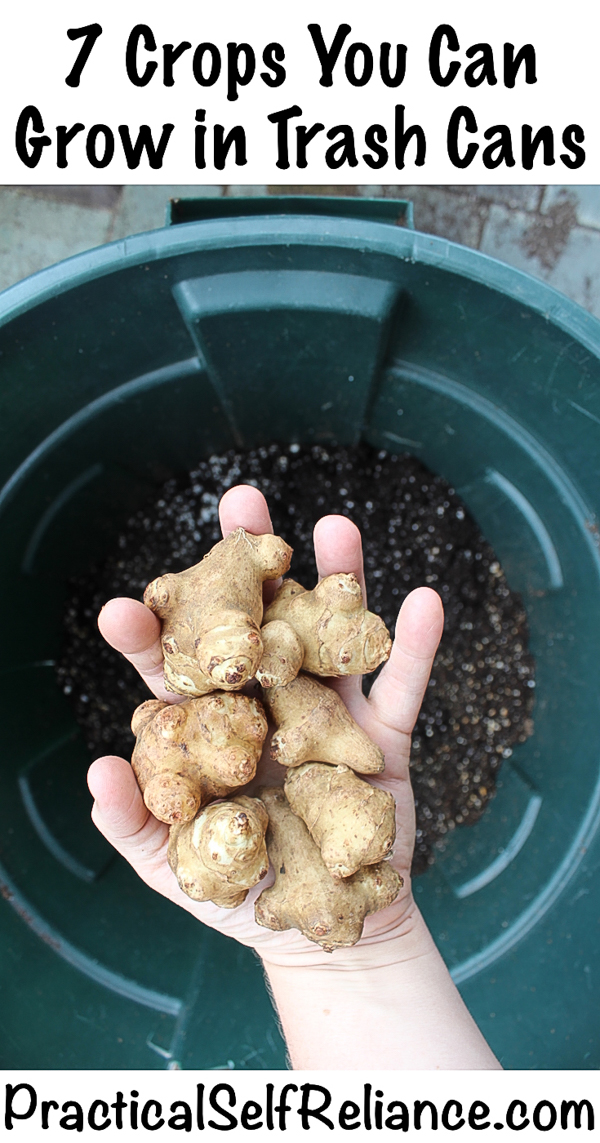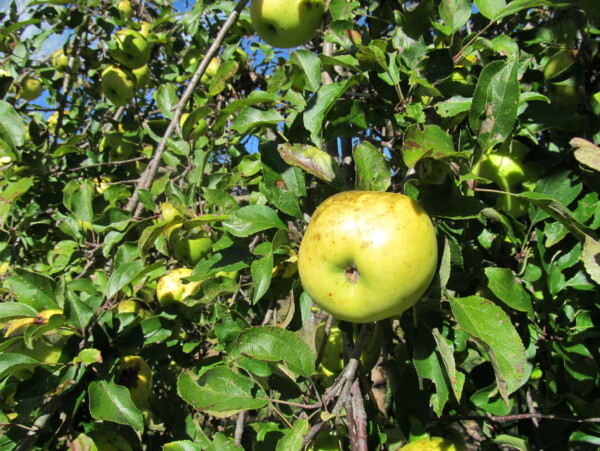Affiliate disclosure: This post may contain affiliate links. Please see our Privacy Policy.
Not everyone has space available for a huge garden, and it can be hard to produce a meaningful amount of food in small containers. With some plants, the trick to a bigger harvest is just a bigger container.
Trash cans may not a glamorous way to garden, but they’ll get the job done in a pinch, and they can be essential for urban survival gardening. There are a number of crops that produce surprisingly well on a deck or patio, provided they have enough space for their roots.

Potatoes
Growing potatoes is one of the quickest ways to produce a substantial amount of your own food. They don’t need a lot of linear space, but the deeper the planter, the more potatoes they’ll produce. That’s why they’re often grown in containers.
As they grow, potatoes are hilled and that puts more of the plant underground and into potato-producing territory. This technique allows you to produce a high volume of food in a very limited amount of space.
Plastic or metal bins work best, as long as there are holes drilled in the bottom for drainage. You can also cut the entire bottom of the can out, but if you plan on moving it all throughout the growing period, leave the bottom in place.
To begin, purchase seed potatoes in bulk. Cut off the eyes and a portion of the potato, then allow the pieces to dry for a day or two before planting.
Plant three to six potatoes cut-side down into the trash can, along with an ample helping of potting soil. Place more soil or compost on top.
Place the can in a sunny location, as it will need about six to eight hours of direct light each day. As the potatoes grow, add three or four inches of soil for every seven inches of growth. Don’t cover the leaves with soil, although you can mulch them.
Once the plants begin to flower and die back, the potatoes are just about ready. Let them mature for two weeks, at which point the leaves will be yellowed and dry, before harvesting your crop.
Sunchokes
Like the lovechild of a sunflower and a potato, sunchokes produce edible tubers below ground and beautiful sunflowers above ground. Sunchokes are easy to grow, possibly too easy.
They can be extremely invasive, and they’re impossible to kill once you plant them in the garden. They’re also a perennial, so they’ll keep coming back year after year.
Unless you have a lot of land and you can isolate them in a back corner, the only safe way to plant sunchokes is in a container. Sunchokes will keep all winter long under the soil, but the tubers spoil quickly once harvested. You can buy them from a farmer’s market or order sunchoke tubers online and plant them immediately for best results.
Miniature Fruit Trees
Dwarf fruit trees such as Meyer lemons, miniature apples, and even cherries and pomegranates can be cultivated in trash cans. The trick to growing trees in containers of any type is making sure you choose the dwarf variety so that it’ll produce fruit while it’s still relatively small.
Make sure the trash can is at least sixteen inches in diameter–the bigger the better here. Poke drainage holes in the bottom, then fill the container with a fertile mixture of soil.
In smaller trash cans, place a small mound in the center of the soil and arrange the roots over the mound before filling the rest of the container. In larger containers, just be sure to spread the roots out when it’s planted so that the tree does not choke itself.
Thoroughly covering the tree’s roots with soil will help the tree remain sturdy while the roots established. Staking is not a bad idea, either.
Keep the soil moist, but not sodden, and give the tree full sun exposure. Fertilize often, as tees are heavy feeders.
They should start producing fruit about a season or so ahead of trees that are planted outside, largely because they don’t have the changing weather with which to contend. You won’t get fruit that is as large as beautiful as with outdoor, full-size trees, but these make a nice addition to your indoor oasis. Just be sure to put a drip tray under them when you bring them indoors to protect your floors.
Tomatoes
Tomatoes are one of the most common container plants grown, but they require lots of root space to thrive. They’ll fare decently in 5-gallon buckets, but a trash can gives them enough space to extend their roots as they would in the ground.
When planting in 5-gallon buckets, choose compact, bushy, and non-vining varieties. For trash cans, go ahead and plant any of your garden favorites and watch them take off!
Dark-colored plastic bins work the best for planting tomatoes, as they help to retain heat and moisture better than other types. Any size trash can will work, provided it’s at least sixteen inches deep, but if with smaller cans be sure to stick to bush tomato varieties.
Use nutrient-dense soil (compost if you have it) and fertilize regularly with compost or worm castings.
This provides a constant source of nutrients for the tomato plants.
You may find you need to stake the plant as it develops, but this is better to do before it sets fruit. This way, you don’t have to worry about damaging vulnerable branches.
Carrots
Growing carrots in trash cans is similar to growing carrots in raised beds. They need loose, non-compacted soil, which makes them optimal candidates for being grown in trash cans or wide storage totes, where you can control the amount of rocks and other hard items in the soil.
To plant, sprinkle a light coating of seeds atop loosely packed, fertile soil, then cover with a half-inch of additional potting dirt.
Water your carrots at least one inch every week. Once the tops emerge, you can also mulch them, to help conserve water and heat. Carrots like plenty of heat, so make sure they are in a nice, sunny location.
They won’t need a full-sized garbage can, and they do particularly well in wide storage totes that are at least 16 inches deep.
My neighbor grows has a large garden, but he grows extra carrots in a Rubbermaid tote every year. He brings the tote into his garage in the fall and cuts down the tops. The cool garage acts like a root cellar, and he’s able to harvest carrots into January even in Vermont.
Peppers
Like tomatoes, peppers grow exceptionally well in containers, and the bigger the better–making them great candidates for trash can gardening. Pepper plants are short-lived, but growing them inside, where you have greater control of the variables, provides them with a lengthier growing season.
You can either plant your peppers plant from seedlings or start by direct seeding. Plant in a pot that is at least a foot deep and wide, with sufficient draining. About three or four plants can be grown in a trash can to maximize your space.
Seeds generally take a week or two to germinate, and then another month or two to produce fruit, depending on your climate and amount of sunlight. Keep the soil slightly moist, and water at the base of the plant. Make sure you add potting soil that is rich in organic matter and fertilize as needed.
While dwarf fruit trees require a large trash can, peppers can get by in something much smaller. Here are instructions on how to create a really classy planter from a small inexpensive trashcan, which you can often pick up for under $1.
Lettuce
You can grow a vast bounty of lettuce in your trash cans for winter use. It grows and produces edible bunches quickly, making it easy to grow in containers. It only needs about six inches of soil, so stick to small, room-sized trash cans or plant lettuce in shallow under-bed storage totes.
Again, your can should have drainage holes poked into the bottom. To plant, sprinkle seeds about an inch apart onto potting mix. Press them into the soil and provide plenty of light until they germinate.
Lettuce does not require much space to grow, and you can plant densely and harvest the thinnings as baby lettuce.
The list doesn’t end here. Most plants can be grown and will thrive on a back patio, in trash cans or other types of containers. If you have a will to grow, there’s a way!





J will suggest one more plant to the list – tiger nuts.
You gave me an excellent idea with this article.
Thank you.
Thanks for the info!
You’re welcome.
I love this! Learned something new and will definitely try it!
I may try Japanese giant radishes in storage containers. Mustard greens are anorher great winter container crop: great stirfried with ginger and garlic.